Delphi Programming & Assembly langage


NEW:
I'm french. Please excuse my awful english...
There are many WEB sites devoted to DELPHI but I do not know one of
them which really exploits the true power of the compiler while speaking
about the programming ASSEMBLER under Delphi 2 .. 6 & Kylix.
Also, I will try this approach by placing at your disposal a
graphic unit encapsulating the DIB and carrying out various
operations. This unit is under development but gives already
appreciable results. It is significant to underline its teaching
aspect because one can find in the sources a very significant mass of
comments and explanations of any kind.
This unit is addressed nevertheless to people, who have some assembly langage
knowledges. If it's not your case, go to Yahoo or Altavista or your favorite
search engine and try "assembly programming" to get the bases and a minimum
knowledge of the thing.
Do not worry, assembly langage is not very difficult and Delphi
facilitates us its use (asm syntax supports variables, records,
procedures, etc... defined in the Pascal parts of the program)
and to reassure you, find here after three examples of the source code.
Because many functionalities of this library avoid having
recourse to GDI calls, we can plan to develop applications, wich only use
those calls (for GDI calls of course). BitBlit functions (memory DIB to video memory)
are very close in all systems, so it's possible of make run a application
under Linux or Win95 & Co with a appearance and a behavior similar!
When it was possible, the methods and properties of TDIBUltra
are identical to those of their TBitmap equivalent. There are
some differences (ex Bitmap.Canvas.MoveTo(x,y) becomes
DIB.MoveTo(x, y) or Bitmap.Canvas.Pen.Color := ClRed becomes
DIB.PenColor := ClRed...) but in general one makes the bearing rather
quickly. Finally remember that this unit has a teaching object too
and that the assembly code is not yet fully optimized. Next version
will undoubtedly be faster...
Last update : 10/18/2001 # VERSION 1.7 #
DIBUltra ver 2.0.0 release coming soon !
New features :
The Mask becomes a real powerful object.
A very efficient TSprite Manager.
Many surprises... ;-)
(Ok, now you read and understood ten pages on the subject).
As a memorandum, you will find here 80x86 asm instructions (french)
(This text is from Gael LE MAHEC).
However, to program seriously it is necessary to have the technical handbook
(format pdf) exempted by INTEL. However before INTEL gives me the right to deliver
its handbook on line, you should better
go to recover it.
Thanks to the Delphi or C++Builder compiler, you have constantly the possibility
to switch in ASM mode while typing:
... your asm instructions...
end;
You can see they are fully commented : (but do not try to understand them
out of their context!)
@LINEHORZT24BITS:
// Trace horizontal line
MOV EAX, Coul
MOV EBX, CoulTmp // Permute the Red color
@RepeatLNX24:
ROL MASQUE, 1 // Repeat Loop
JNC @LNX24NOTRACE // If PlotON Then Begin
MOV [EDI + 0], AL // PxB^[Pt] := CoulB; <--- [Mem] <= AL (8 bits)
MOV [EDI + 1], AH // PxB^[Pt] := CoulV; <--- [Mem] <= AH (8 bits)
MOV [EDI + 2], BL // PxB^[Pt] := CoulR; <--- [Mem] <= DH (8 bits)
@LNX24NOTRACE: // End Else ; ----------
ADD EDI, AdXPlus // Inc(Pt,AdXPlus); = 24 bits
SUB ECX, PasX // Dec(dx, PasX)
JNZ @RepeatLNX24 // Until (dx=0);
MOV EBX, PasY
ADD EDI, AdYPlus // Inc(Pt,AdYPlus)
RET
// During the double indirection, we calculate:
// Seg.dy := Seg.y2 - Seg.y1;
// Seg.dx := Seg.x2 - Seg.x1;
// That removes the data dependance between instructions
// and avoids the cycles of freeze of the
// processor (standard Pentium and successor x86)
MOV ECX, Seg.y2 {Calculation of Seg.dy}
LEA EAX, [EAX * 1 + @Table1] // Double Indirection : first level
SUB ECX, Seg.y1 {Calculation of Seg.dy}
MOVZX EAX, BYTE PTR [EAX] // Double Indirection : Recovery of N of One N Goto
MOV Seg.dy, ECX {Calculation of Seg.dy}
LEA EAX, [EAX * 4 + @Table2] // Double Indirection : second level
MOV ECX, Seg.x2 {Calculation of Seg.dx }
MOV EAX, [EAX] // Prepare to JUMP
SUB ECX, Seg.x1 {Calculation of Seg.dx}
MOV Seg.&dy,ECX {Calculation of Seg.dx}
JMP EAX // GO ! : On X Goto n1,n2,n3,n4,n5...
procedure TDIBUltra.RotateStyle (n : Byte); assembler;
asm // turn around the mask (N Modulo 32) times
MOV CL, n
ROL [Self].Mask, CL
End;
function TDIBUltra.PlotON : Boolean; assembler;
asm
MOV Result, True
ROL [Self].Mask, 1
JC @End
MOV Result, False
@End:
End;
procedure TDIBUltra.PrepareStyle; assembler;
asm // Turn around the mask until presenting a printable point
MOV EAX, [Self].Mask
BSR ECX, EAX
SUB ECX, 31
NEG ECX
ROL [Self].Mask, CL
End ;
EXTENSION of DIBUltra:
I will not detail here the functionalities of the DIBUltra unit
knowing that 7 small projects are provided to explain its use.
Of course, all the projects are provided with the sources.
The current licence is the GNU Licence.
Let us say simply that DIBUltra makes it possible to trace in a faster way of
the GDI of Windows, the lines. (the function Pixels[x,y] := ClColor
is for example 10 times faster) This unit implements a PenStyle (not,
dashes, defined by the user...) very easy to use.
DIBUltra has his own format of compressed images DIBs (but can also
read normal BMP). A clipping zone can be freely defined by the user
who can thus limit his layout. A TDIBUltra object is typically used
except screen, (in Blit surfaces), so DIBUltra offers buffering management
functions.
The last version (1.5) corrects some bugs and brings the
support of the Alpha layer (various densities of transparency are
possible, definable before (with your favorite drawing editor). You can
now choose a pen mode (COPY, ORPEN, ANDPEN, XORPEN...)
The 7 small applications provided with DIBUltra show:
Compress : - the use of the methods of the images loading / saving on disk / resource / stream.
Drawing : - the use of the style of brush (dash, dot, dashdotdot ...), of the indexed colors, ScanLine, Buffering.
ScreenSplash : - how to show a screensplash logo (like DIBUltra logo) (see it !)
SimpleDemo : - a very simple demo for beginner (someone ask for that !)
AlphaDemo : - the use of the AlphaChanelBlit function to display an image with various levels of transparency.
AlphaTool : * This application makes it possible to compile compressed images incorporating the Alpha layer.
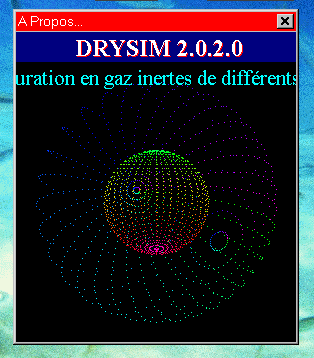
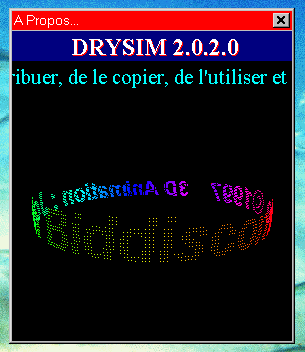
Idem a few seconds later...
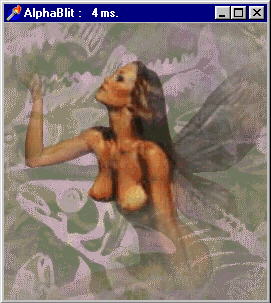
The unreal fairy is displayed with certain
very transparent zones and others opaque...
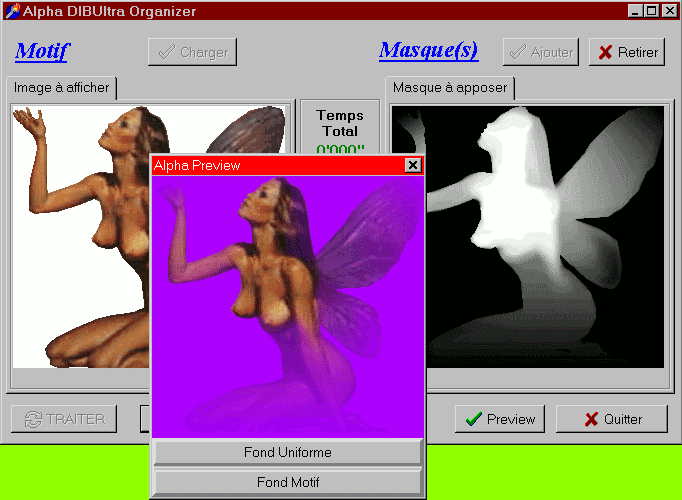
To build a Alpha layer DIB, a small utility assembles
the various files (the image and its mask).
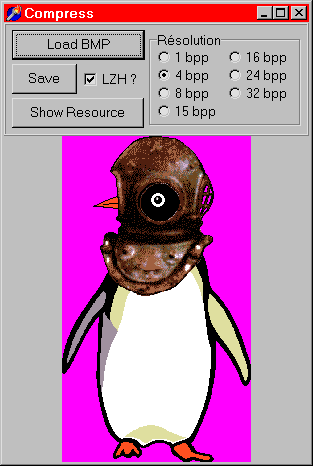
The application of the methods LoadFrom / SaveTo
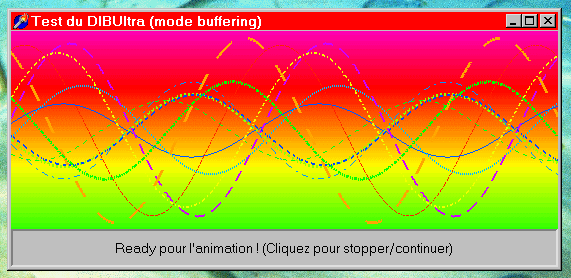
The window of tracing of the multiple lines...
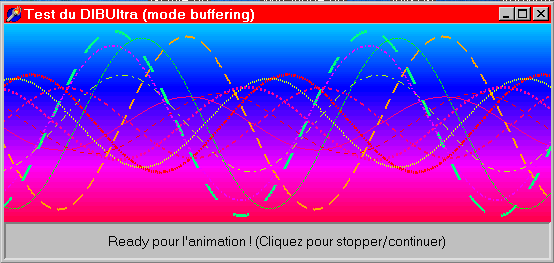
And with various styles!
DIBUltra breaks up into 4 units:
Discussed enough good, let us pass to the downloading units
with the examples projects:
DIBUltra (1.3) with BINARY EXE + SOURCES 780 KB
DIBUltra (1.7 !!) with SOURCES NOT COMPILED 337 KB (better not?)
Enjoy yourself !